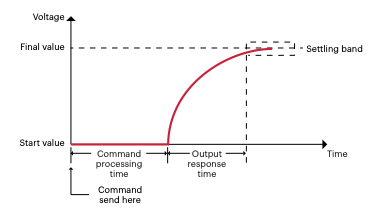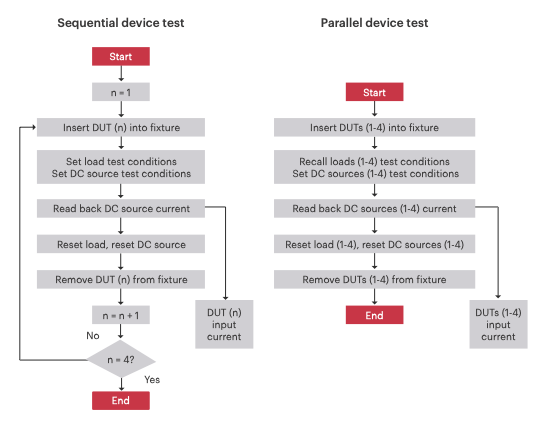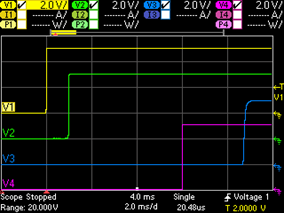
How to significantly boost ATE power supply throughput
Your job as a test engineer is not an easy one. There is constant pressure to reduce costs and increase system throughput. Today I would like to discuss critical areas that impact system throughput and how you can reduce ATE test costs.
Programming and command processing speeds
In figure 1, you can see the four main power supply attributes directly impacting test time: command processing time, output response time, and output settling time. A reduction in any of these can significantly reduce costs.

For example, basic power supplies can have output response times in the 10s or 100s of milliseconds. In contrast, a high-performance power supply can achieve less than one millisecond for up and down programming speeds. Many ATE tests require numerous voltage shifts, so the cumulative effect of a slight reduction in test time can be great.
Measurement sample rate
Measurement sample rate is also a critical factor in the speed performance of a power supply. This represents how frequently a power supply can capture a measurement on the DUT. Speeding up command processing and output response time is only valuable if your power supply can quickly capture measurements at each voltage level. This is where having a fast sample rate is critical. High-performance power supplies can offer programmable sample rates at least 60 times faster than a basic power supply's fixed rate.
Parallel Device Testing
Changing from serial to parallel device testing can dramatically increase test system throughput. A large portion of test execution activity may involve setting conditions and making measurements using the DC power supply. Configuring the test system so it can simultaneously execute tests on multiple devices using multiple DC sources is a cost-effective way to improve test throughput significantly.
Figure 2 illustrates a sequential device test versus a parallel device test. In the sequential test, you can see that the test loops through the sequence four times — once for each of the four DUTs. By contrast, test execution for the parallel device test system only has to pass once through the sequence for all four DUTs.

Output sequencing to test system power up and down
It is often difficult, if not impossible, to sequence and ramp up or down multiple bias voltages with specified timing conditions using separate programmable system power supplies. Even most conventional multiple-output system power supplies do not adequately address this need.
For example, suppose your DUTs have multiple power supply inputs, such as satellite payloads. In this case, you need to properly sequence, on or off, each power supply at strictly repeatable times to prevent current surges and latch-up conditions. In addition, you may need to set the ramp rate of each supply to turn-on or turn-off at a special rate. Advanced power supplies will help you overcome these test challenges by providing a built-in sequencing capability across mainframes and adjustable slew rate control at turn-on or turn-off. These built-in capabilities provide a straightforward way to properly power on or off your DUT during a test.

Using an advanced power supply, you can test DUTs to their specified bias voltage timing during ramp-up and ramp-down with millisecond accuracy. Many standard power supplies can only support accuracy within the 100s of milliseconds. In addition, it is also possible to determine DUT sequencing and ramping limits by adjusting sequence timing and slew rates of the multiple bias voltages.
transient properties of AWGs for stress testing DUTs
During testing, you often need to simulate power waveforms to reproduce the power environment the DUT will face in the real world. This is especially the case with DUTs operating in rugged environments that experience transient behavior from the power source, such as voltage dropouts or surges. Therefore, it is essential to select a power supply that can simulate either voltage or current transients for testing.
When selecting a power supply for its transient response capabilities, it is crucial to consider its timing properties. These timing properties include rise time, fall time, and dwell time. High-performance power supplies like the Keysight Advanced Power System N6900 and N7900 Series power supplies can generate timings of less than one millisecond.
Additional Resources
For more detailed information on these topics, please review the white paper I developed, Three Ways to Boost ATE Power Supply Throughput.